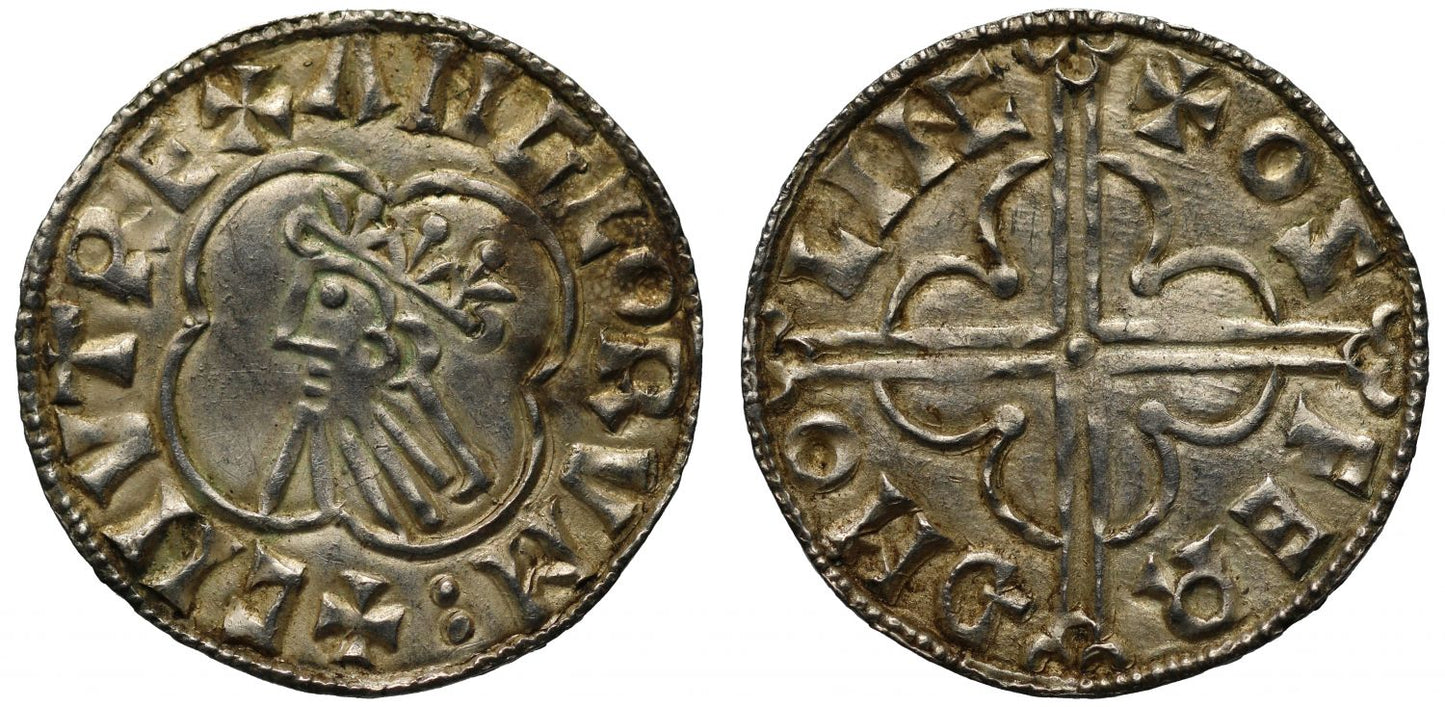FAQs
What makes a coin valuable?
I have coins to sell, what’s the next step?
How will my purchases be shipped?
What happens if I’m not entirely happy with my purchase?
Canute Penny, Quatrefoil type, Lincoln Mint, Moneyer Osferth
Canute (1016-35), silver quatrefoil Penny (c.1017-25), Lincoln Mint, Moneyer Osferth, crowned and draped bust left within quatrefoil, legend surrounding commences at bottom, +CNVT REX ANGLORVM:, rev. pellet at centre of voided long cross, over quatrefoil with pellet cusps, legend surrounding, +OS FER Ð MO LINC, with the NC ligatured, weight 1.11g (SCBI Lincolnshire 27:365; BMC type VIII 310; N.781; S.1157). Lightly toned with one blemish on obverse, good very fine.
The legends translate as "Canute King of the English" on obverse and on the reverse "Osferth of Lincoln."
This coin is of the early Lincoln style, as defined by Blackburn and Lyon in their article "Regional Die Production in Cnut's Quatrefoil Issue." These dies were therefore cut at Lincoln. Despite Canute being essentially a Viking King from overseas, the coinages of England continued in a similar vein to those of Aethelred II, in that the types changed every six years, meaning there are three main types for this reign, of which the quatrefoil type was the first. According to North there were up to 74 mints in operation with perhaps four other enigmatic places that remain uncertain. Lincoln operated with up to 57 moneyers in this reign through four types.
Canute could have been as young as 21 when he ascended the English throne after the 28th November 1016 upon the death of Edmund "Ironside" at Oxford. Though Edmund son of Aethelred II had a younger brother and two infant sons his advisers recognized Canute as successor. Though his birth date is not known, Canute was a commander in his Father's army from 1012, and at first had to settle a number of uprisings amongst the nobility and others, which he quelled by maintaining a large army and navy from heavy taxation. He kept Wessex at first for himself whilst dividing up other areas for regional government under trusted Danish allies. Canute had married Aelfgifu daughter of Ealdorman Aelfhelm of Northumbria, but set her aside to marry Aethelred's widow Emma in 1017 who had fled to Normandy, and this latter union helped maintain the political continuity and tradition of English Kingship. Harald of Denmark died childless in 1018 and Canute used his English troops and finance to extend power to Scandanvia making his infant son Harthacanute titular Governor and heir of Denmark. Canute attempted to invade Sweden, and actually took Norway in 1028 having had a pilgrimage to Rome the year before. Canute left his eldest son by Aelfgifu, Swein to rule Norway and was now the most powerful King of England ever at this time and is likely when the apocryphal story of him trying to vainly order the coastal tide to turn and retreat in front of his courtiers emerged. However, Norway was lost by 1034, Canute did not respond, and he passed away suddenly at Shaftesbury in his mid-forties on the 12th November 1035.
The City of Lincoln situated on the north bank of the River Witham some 33 miles north east of Nottingham was occupied by the Danes in 918 but the army there submitted to Edward the Elder and in 942 was one of the Five Boroughs. William I built a castle here in 1067 and the minster of St Mary was taken by Remigius of Dorchester as his cathedral in 1072. Later Rannulf the Earl of Chester and William de Roumare Earl of Loncoln, seized the castle to hold against King Stephen in 1140. The King besieged the castle and was captured in defeat at the Battle of Lincoln with the town sacked and burnt. The castle was later surrendered to Stephen by Rannulf who three years later granted it back to him.
Minting activity is thought to commence here with the "St Martin" coinage and then from Eadred to Henry III. In the middle of the reign of Henry I the signature of the Lincoln Mint changes to NICOLE until the end of Stephen's first type and in some later short cross coinage, this being a French name for the city seen in some mediaeval documents, with Lincolnia being the name in Latin.
Provenance:
Ex J. Kite Collection, purchased by Michael Trenerry of Truro.
Ex Collection of an English Doctor part II, Sovereign Rarities fixed price list online May 2022.
FAQs
What makes a coin valuable?
I have coins to sell, what’s the next step?
How will my purchases be shipped?
What happens if I’m not entirely happy with my purchase?













